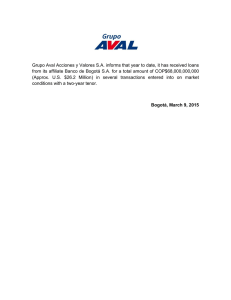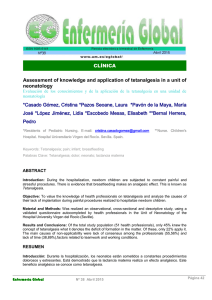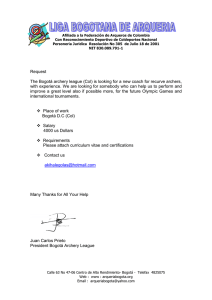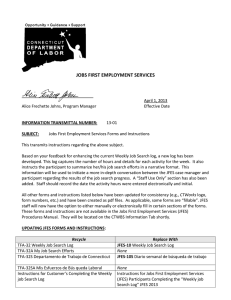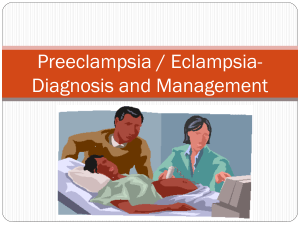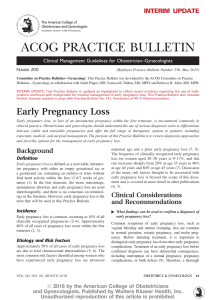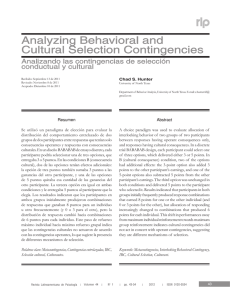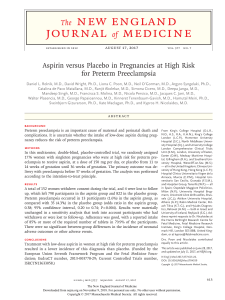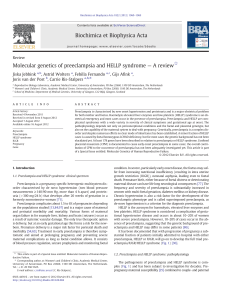English
Anuncio
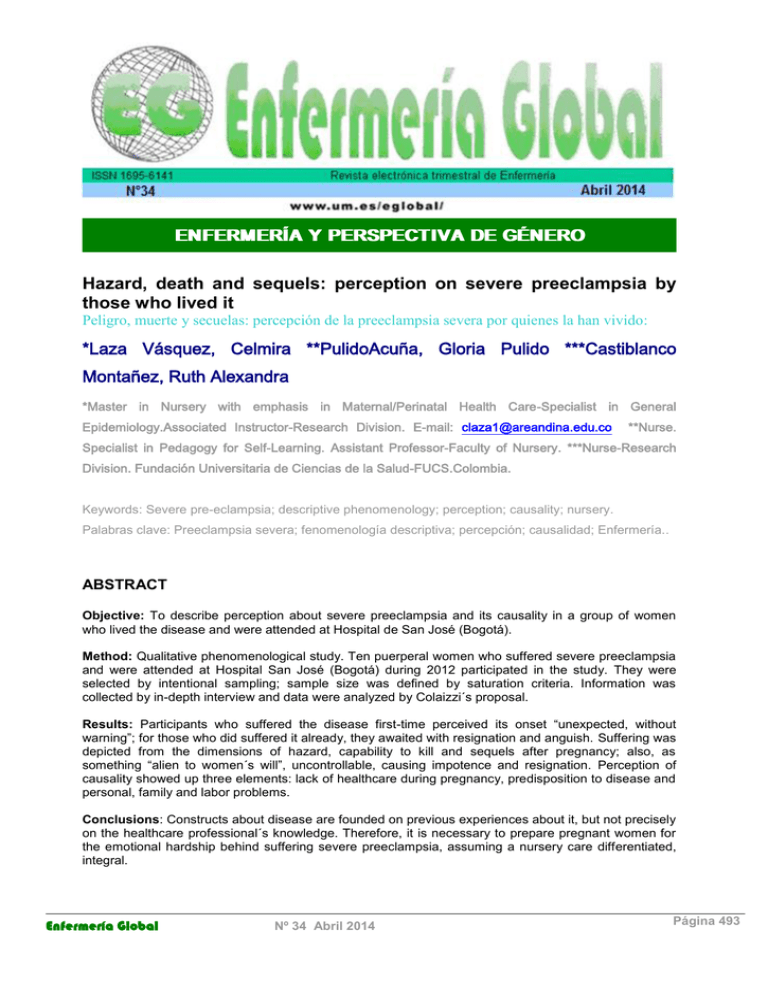
ENFERMERÍA Y PERSPECTIVA DE GÉNERO Hazard, death and sequels: perception on severe preeclampsia by those who lived it Peligro, muerte y secuelas: percepción de la preeclampsia severa por quienes la han vivido: *Laza Vásquez, Celmira **PulidoAcuña, Gloria Pulido ***Castiblanco Montañez, Ruth Alexandra *Master in Nursery with emphasis in Maternal/Perinatal Health Care-Specialist in General Epidemiology.Associated Instructor-Research Division. E-mail: claza1@areandina.edu.co **Nurse. Specialist in Pedagogy for Self-Learning. Assistant Professor-Faculty of Nursery. ***Nurse-Research Division. Fundación Universitaria de Ciencias de la Salud-FUCS.Colombia. Keywords: Severe pre-eclampsia; descriptive phenomenology; perception; causality; nursery. Palabras clave: Preeclampsia severa; fenomenología descriptiva; percepción; causalidad; Enfermería.. ABSTRACT Objective: To describe perception about severe preeclampsia and its causality in a group of women who lived the disease and were attended at Hospital de San José (Bogotá). Method: Qualitative phenomenological study. Ten puerperal women who suffered severe preeclampsia and were attended at Hospital San José (Bogotá) during 2012 participated in the study. They were selected by intentional sampling; sample size was defined by saturation criteria. Information was collected by in-depth interview and data were analyzed by Colaizzi´s proposal. Results: Participants who suffered the disease first-time perceived its onset “unexpected, without warning”; for those who did suffered it already, they awaited with resignation and anguish. Suffering was depicted from the dimensions of hazard, capability to kill and sequels after pregnancy; also, as something “alien to women´s will”, uncontrollable, causing impotence and resignation. Perception of causality showed up three elements: lack of healthcare during pregnancy, predisposition to disease and personal, family and labor problems. Conclusions: Constructs about disease are founded on previous experiences about it, but not precisely on the healthcare professional´s knowledge. Therefore, it is necessary to prepare pregnant women for the emotional hardship behind suffering severe preeclampsia, assuming a nursery care differentiated, integral. Enfermería Global Nº 34 Abril 2014 Página 493 RESUMEN Objetivo: Describir la percepción acerca de la preeclampsia severa y su causalidad en un grupo de mujeres que vivenciaron la enfermedad y fueron atendidas en el Hospital de San José-Bogotá. Método: Estudio cualitativo fenomenológico. Participaron diez mujeres puérperas que presentaron una preeclampsia severa y fueron atendidas en el Hospital de San José (Bogotá-Colombia) durante el año 2012. Se seleccionaron mediante un muestreo intencional y el tamaño de la muestra se determinó por el criterio de saturación de la información. La información se recolectó a través de una entrevista a profundidad y los datos se analizaron mediante la propuesta de Colaizzi. Resultados: Las participantes que sufrieron por primera vez la enfermedad percibieron su aparición de forma “inesperada y sin avisar”; para las que la habían padecido, la esperaron con resignación y angustia. El padecimiento se construyó desde las dimensiones de peligrosidad y capacidad de causar muerte y secuelas posteriores a la gestación. Además, como algo “ajeno” a la voluntad de la mujer”, imposible de controlar; generando impotencia y resignación. La percepción de la causalidad evidenció tres elementos: falta de cuidados durante la gestación, predisposición a la enfermedad y problemas familiares, personales y laborales. Conclusiones: Las construcciones de acerca de la enfermedad se cimentan en las experiencias vividas frente a ella y no precisamente frente al conocimiento trasmitido por los profesionales. Por esto, es necesario preparar las gestantes para el impacto emocional que supone enfrentarse esta; asumiendo un cuidado de enfermería diferenciado e integral. INTRODUCTION Severe pre-eclampsia is classified as one of the hypertensive diseases during pregnancy. These are considered as a multi-systemic disorder exclusive to humans, which cause is still unknown. Their features show up as a result of an abnormal vascular response to placentation1. Diagnosis of severe pre-eclampsia is made in women with hypertension and proteinuria of sudden appearance, together with one or more of the following symptoms: central nervous system alteration (blurred vision, scotomas and intense headache); epigastric pain or at upper right quadrant (due to distention or rupture of hepatic capsule). There are also the following signs: marked rise of arterial pressure (greater than 160/110 mmHg measured on two separated occasions with at least 6hour difference) and pulmonary edema. Added to this, proteinuria greater than 5 g/24 h, oliguria (less than 500 mL/24 h), hepatocellular anomalies (serum transaminases twofold over normal), trombocitopenia(less than 100.000 platelets/mm 3) and coagulopathy. Only one of these features is required to make diagnosis of severe preeclampsia2. In Colombia, hypertensive disease at pregnancy has turned into the first specific cause of maternal mortality; in 2006, this proportion was between 23,8% and 50% at level-3 institutions (depending on population base)3; causing a five-fold rise of perinatal mortality4. On the other part, severa studies have reported high morbidity due to this disease5,6,7,8. However, in spite of the importance gained by pre-eclampsia in the context of maternal health, there are no studies at the country and are scarce worldwide when reporting other non-biological dimensions of health-disease process, from the point of view and voices of pregnant women9,10,11. In this sense, it has been raised that there are very important topics when developing stratregies to improve health conditions of pregnant Enfermería Global Nº 34 Abril 2014 Página 494 women; the efficacy and the effectiveness of any started activity in this matter depend upon the perspectives of both pregnant women and their families 12. Unfortunately, information available in Colombia about what they think and feel about the risk of pregnancy, the antenatal control, the health care or the hospital delivery, among other issues, is scarce and has low or null relevance13. Therefore, it is proposed in this paper to describe perception about severe preeclampsia and its causality from the experiences of a group of women who were attended at Hospital de San José-Bogotá during 2012. These results are part of a study bigger in both size and scope which describes the experiences endured by this group of women about the disease. MATERIALS & METHODS A qualitative phenomenologic study was made; it describes the meaning of an experience from the point of view of those who had it. So, the whole structure of the experience is represented, including the meaning of the experiences for the individuals, focusing on its comprehension but not its explanation 14. Population was composed by ten puerperal women with three months postpartum, who during their last pregnancy were diagnosed with severe pre-eclampsia and were attended at the Service of Ginecology& Obstetrics, Hospital de San José(BogotáColombia). Criteria for taking part were: women 18+ year-old, living at Bogotá, with no psychological anomalies because of the pregnancy at study and who were willing to speak openly about their experience. An intentional sampling15was used to select the participants keeping in mind both the need forstudy information and the needs detected in the results. In this regard, it was based upon researchers´opinion to sample the subjects according to their typical character; choosing them using the already defined participation criteria leaving out random procedures, looking for those subjects who might give the best and most information possible about the phenomena under study. To define sample size the criteria of information saturation was considered15, by which sample size was defined according to both quantity and quality of information given by the participants. Thus, they were selected until there was no new information to widen the scope or to seek further into the studied phenomena and it became redundant. The co-authors were the instrument of information recollection themselves 16. Data collection technique was the in-depth interview, useful for a subject to speak to the interviewer their personal definition of the situation, following the model of a pair-topair conversation and not a formal exchange of questions and answers 17. Each participant was interviewed twice, each intervie with an approximate total duration of one hour. Interviews were completely transcribed for analysis; from the first interview the second one was planned, until reaching information saturation for each participant. Access to puerperal women to invite them to participate in the project was made at the post-partum consultation (between 7 to 10 days after leaving hospital). For this, the help of the Service of Ginecology& Obstetrics at the hospital was obtained to identify women who suffered high-risk pregnancy due to severe pre-eclampsia. Interviews were programmed between 1 and 3 months after leaving hospital, and were made at the institution or each woman´s house, depending on her decision. Enfermería Global Nº 34 Abril 2014 Página 495 Results were e-mailed back to participants and, through this feedback, adjusted before presentation. Data were treated according the phenomenological analysis proposal by Colaizzi18following these steps: reading participants´description of phenomenon to acquire a feeling about their experience and give sense to their tale; extraction of significant declarations directly relevant to the phenomenon; formulation of meanings for those declarations; categorization of meanings as per group of topics in common to all participants; integration of findings in an exhaustive description of the phenomenon under study; proposition of a prototype for the theoretical model about the phenomenon; validation of findings, turning to some of the participants asking how they compared with their own experiences, and incorporation of the changes offered by them in the final description of the phenomenon´s essence. During the research the criteria of methodologic rigor (credibility, auditability, transferibility) were taken into account19, and the ethical considerations recorded in the Ministry of Health Resolution 008430/1993 were followed 20. Also, study was approved by Ethics Committee for Research in Human Beings (Hospital San José-FUCS), and there was a form of informed consent to be filled by each participant. RESULTS Participants` features and context. This study was held Hospital de San José (Bogotá-Colombia). This is a university institution, level-3 (the most specialized), private in nature, which offers services to population of low socioeconomic strata (levels 1 to 3). Ten women participated, who were at mediate puerperium (3+ months) and whose delivery and immediate puerperium were attended at the institution. All the participants lived at Bogotá and belonged to socioeconomic strata 2 or 3. Women`s age range was between 20 and 42 year-old; seven of them lived with their mates; two were married and one was single. Seven of the puerperal women had suffered pre-eclampsia for the first time, the others twice. Only one pregnancy was planned; however, all women as well as their mates accepted the pregnancy and wished a birth without complications; there was one stillbirth. Perception of severe pre-eclampsia: a view from those women who endured it. First-timer pregnant women or those who never suffered the disease before expressed they had knowledge about it, but they did not understand many things when it appeared: “…I said: ¿How they say I had pre-eclampsia since I had it at delivery time, but not months before? (Participant #6). This group felt the disease came with a sudden, unexpected manner; causing a shocking surprise which affected the normal course of pregnancy and the possibility for a birth with no complications of the so-wished child: “… for indeed it was so silent…” (Participant # 9). However, for those women who already suffered the disease in a previous gestation, in spite of an express prohibition to conceive again, they awaited it with resignation and agonizing wait: “And I said to myself: no, perhaps this anxiety during nine months, Enfermería Global Nº 34 Abril 2014 Página 496 that ¿when I am going to suffer that pre-eclampsia?(Participant # 4). With sound knowledge about the disease and its alarm signs, to wait for it included a rigorous care plan based upon –apart from their past experience- the information transmitted by health care professionals. Severe pre-eclampsia was perceived as something baffling reaching during pregnancy: “… the truth is difficult because one does not know directly what is going to happen” (Participant # 3). Besides, it is felt as a disease “apart from woman´s will”, assuming the pregnant body as accountable since it reacted to “something” to be difficult to understand or explain. So, they considered its onset as unstoppable, as well as its development and consequences for the health of both mother and child “… because it [the severe pre-eclampsia] may be dangerous and I was unaware, I wanted for me the best of experiences. Then I said: I am not going to be defeated by nothing, I am going to try to be happy, I am going to suffer nothing. I said to my baby: you are going to stay until July, you are not going to leave for no reason…We were prepared in a sense for something not so serious to happen” (Participant #9). Due to this, women felt they could do nothing against this sickness, hence causing feelings of impotence, leaving only resignation. So one of the women spoke of it: “For just one must resign oneself, because if it is one´s turn, it is so” (Participant # 3). For every woman, both those who suffered pre-eclampsia for the first time and those who already had it, they described the illness with negative terms such as terrible, severe, bad, burdensome, among others; and their onset at pregnancy was defined as “shocking”. “Life-threating [severe pre-eclampsia]. This is no game, this is not any cold. This is something to be aware of. For it is not simply high blood pressure. It may cause stroke. Apart from that, it damages all organs because heart has to work more, kidney, everything” (Participant #10). Perhaps the most significant in participants` stories were the dimensions of hazard (power to harm) and to cause death in both pregnant women and their children due to severe pre-eclampsia. “I always have heard about women who suffer pre-eclampsia, virtually there are some who even die. It is very dangerous…” (Participant #6). “Most of the women, who were pregnant, do not understand how important, how grave is to have pre-eclampsia. One does not imagine it would be so grave and look, one could die of it” (Participant #4). Likewise, a third dimension was its possibility to cause sequels on both mother and child after pregnancy. At women, it caused further concern because of the sequels after pregnancy, given the permanent damages to kidneys and cardiovascular system, evident in trouble to keep blood pressure in check. “I knew it was something bad, but I did not know it had so many consequences and affected many organs directly” (Participant # 3). “… one thinks: hopefully I have no sequels because of it [severe pre-eclampsia], that I do not get sick because of kidney or heart for the last time it happened to me… Then one is concerned right now, hopefully they will control my blood pressure fastand I will not get with something complicated, that there will not be a damaged organ” (Participant #4). About their children, they felt the alterations that put their lives in danger caused them to be hospitalized in a Neonatal Intensive Care Unit (NICU) where they underwent Enfermería Global Nº 34 Abril 2014 Página 497 complex, painful procedures because of the disease; besides of the sudden halt to their intrauterine life. “Even so, it [severe pre-eclampsia] affected the lung, for she suffered pneumonia in a lung, and I said: probably pre-eclampsia affected her too” (Participant #3). Because its hazard and possibility of sequels felt by women about the disease; and due to recommendations given by doctors who attended them, some expressed their decision to conceive no more children. “Experience one learns, lifetime, it is really serious… And I feel fear, to have another baby. No, I would say no, for it caused me fear. No, I do not want to repeat it” (Participant #2). Perception of causality: beyond the biologic. - Lack of care during pregnancy. Within causality as perceived by the participants, lack of care during pregnancy is perhaps what has the greatest burden of meanings for them. Not to change life-styles such as not reducing rhythm of rutinary activities they undertook before pregnancy, to combine activities such as working and studying, the extended workdays, not allowing to rest during day and to get into bed very late at night. “What I say to you, it was time, run from one place to another. Suddenly, this caused I had not enough care as a pregnant woman…” (Participant # 5). All of this made difficult for woman to take care of her pregnancy and caused a stress meant as detrimental for both her and her child. “I would believe that maybe the work stress. I would say that stress while studying, while at work, those long workdays, the time of no-rest, not having time to rest…” (Participant # 5). Added to this, they said that an inadequate diet turn into a factor they perceived as a trigger of the disease. “Diet… it was to feed a little better, at specific hours, I did not do it, I did not have such a care… And the rest, the time to rest. One cannot be exceeding oneself so much, running so much. And I did it a lot, for my work and my career” (Participant # 3). Besides, not to assist to antenatal care was another aspect perceived as important to know how pregnancy evolved and to identify trouble. One of the women talked: “And apart from this, the antenatal care. I began very late; I began a little bit after the third month. Of course, I began very late and suddenly they could detect proteinuria then or, I do not know, an onset of pre-eclampsia, just to have a warning. As I did not go to these controls with dedication…” (Participant # 2). Against this, women who already have suffered pre-eclampsia in the past, developed a series of actions for their own health care during their pregnancy in order to somewhat avoid the severity and early onset of the disease. “Eleven years later I thought: No, eleven years later I do not believe I am going to suffer pre-eclampsia. I said: no, I know I am going tho deliver well… I am going to take care. That is why I cared myself a lot” (Participant # 7). Food practices such as reducing salt, sugar, fats and carbohydrate consumption, as well as increasing animal proteins and vegetables were executed. Other cultural Enfermería Global Nº 34 Abril 2014 Página 498 practices women were considered useful to lower blood pressure, such as an infusion of parsley and garlic. Besides this, some of the participants referred following medical instructions, such as medication for hypertension on a regular basis and using the recommended ones. So it is narrated by one of them: “… I took care of my blood pressure… of taking my pills [medications], of living a quiet life, of walking from time to time. Yes! All the things they told me to do. And in part I believe I was about to suffer it but not as they expected”. (Participant # 8). One of the women who had acute kidney failure referred more extreme actions, such as regular blood pressure measurements at home during pregnancy: “… I bought a tensiometer. All the time measuring blood pressure, all the time extra careful taking the medications, measuring fluids… always quite aware of all those things…”(Participant 8). One interesting issue is that care during this period,as informed, was assumed as a family matter. “They took care of me, my husband, my mother, well”. (Participant # 4). “… My husband also prepared the infusions for me, parsley infusions with a garlic clove. He gave it to me, something homemade for blood pressure”. (Participant # 7). This fact evidenced elements of social support by the primary networks during pregnancy. - Propension to disease. To suffer chronic hypertension turned into a perceived cause for a severe preeclampsia to appear during pregnancy, although difference between both diseases was clear. “But well, as I am a chronic hypertense anyway… I took care a lot, however I suffered it… I suffered it anyway, in spite of food, salt, sugar, diet, medications. I suffered it anyway”. (Participant # 4). On the other part, diagnosis of pre-eclampsia in a past pregnancy was the second reason to have propension to disease during present pregnancy. “I do not know, I believe I suffered it at the first pregnancy, it appeared in this too…” (Participant # 7). Disease onset in other women of the family was perceived as the third cause of propension. “I said: if all my pregnancy was well… Why? If all of my sisters´ pregnancies were well, why me?.(Participant # 10). - Family, personal and labor problems causing stress. Family, personal and labor problems were referred by all participants as a disease cause. Preocupations and difficulties at home with the closest relatives were the reason behind the most important problems. “There were moments when, yes, I fought a lot with my baby´s father, and when I fought with him, headache began, blood pressure increased. Sometimes I tell him it was a reason too.” (Participant # 2). As for personal issues, it was of note the concern about situation of the children who remained at home during women´s hospitalization for disease attention, delivery or immediate puerperium; as well as the procedures made on them during this time. “… I Enfermería Global Nº 34 Abril 2014 Página 499 was there until the 24th [of December] but because of concern for my children… Blood pressure did not lower”. (Participant # 3). Besides, inconvenients at work places -informed as lack of comprehension given the pregnancy status- turned into another situation which caused stress on woman. “… I came back again due to headache, because I had an inconvenient at work. Then, hospitalization again…” (Participant # 3). All these situations turned into perceived sources of stress during pregnancy, causing bad mood, unrestlessness and blood pressure rise. Likewise, it implied for them additional effort in order to restrain emotions due to all these situations, which they assumed as stressful to avoid blood pressure rise and onset of other symptoms of preeclampsia. “Then, in spite I was afraid, one tries to restrain, one tries to restrain emotions, because of the blood pressure.” (Participant # 7). DISCUSION Perception on a disease is criss-crossed by a series of factors related to structural determinants such as the own life experience, and is included inside the general process of perception. This process is necessarily selective and may be compared with looking a mirror, which reflects an image that is not the very reality. In this “mirror”, image takes different shapes according to where we are to look at it. Likewise, our own perception about reality is produced according to the way and place/situation from which we look at it. Therefore, possibilities to perceive a health problem are very diverse and are socio-culturally conditioned21. This is the logic behind the results of this study; discrepancies were evident about conceptions built around severe pre-eclpamsia by the women who endured it and by the biomedical system. To the former, constructs are supported by experiences endured directly, but not solely from the wisdom transmitted by health professionals about the disease; to the latter, about a knowledge acquired from science but not from life experience. There is only a common point between both views: hazard by severe pre-eclampsia on the mother-fetus pair. This wrapped all women who endured the diseasein a shroud of uncertainty and fear. And beyond its severity, this disease had quite similar connotations to those already reported in literature23, where disease´s perception was related to three issues: death, sequels and ignorance about what would happen. Added to this was the “unexpected, sudden” impact of diagnosis for those women who never suffered the disease, which interfered with the wish and longing for both pregnancy and baby. It caused some anxiety and fear on the diagnosis when related to the disease itself and the implications to their health and their children, given the magnitude granted to severe pre-eclampsia. This three perceived dimensions: hazard, death and sequels for both mother and baby, as well as their sudden nature, definitely marred the women´s sweet and long awaited moment of their babies´ birth. Another element in the perception about disease is the connotation of “strange” to them, not to their body but their will, implying lack of control and feelings of impotence and resignation against it; disarming the women and causing even more fear and Enfermería Global Nº 34 Abril 2014 Página 500 uncertainty. This has been related with results from other studies, where high-risk pregnancy has been represented as associated to failures of the mother during pregnancy, thus resulting in her body´s rejection to fetus, causing her not only feelings of guilt22. Apart from the perceived differences about disease, this discrepancy also was a reality in the attributed causality by women. For the biomedical system, there is no clear cause for the disease, although there are some causal factors such as patient history of hypertension, gestational diabetes or autoimmune disease; personal or familiar history of pre-eclampsia (in mother, father or sisters), first pregnancy (closely linked to mother´s youth), multiple pregnancy, overweight or obesity before pregnancy, fetal malformations and separation from baby´s father12. However, women perceive causality as something close, personal and dependent upon them; perhaps a little separated from the biologic, exception made of the predisposition to suffer the disease. So, in line with other studies, it is reaffirmed that – from woman´s experience- severe pre-eclampsia appears due to her lack of care during pregnancy11and personal, familiar and labor dificulties9 besides that predisposition23.This goes far beyond alopatic medicine´s position, assuming a perspective on etiology, body, treatment and disease all seen as merely symptoms and signs. CONCLUSIONS Participants´ voices highlight the need to keep in mind that differences in perception of those who have suffered disease are related to diverse ways to define health-disease imbalances, and to create solutions for them; as well as the beliefs behind them. These are collective processes quite rooted around social and cultural constructs on body, health and disease, which are evident at the individual level. It implies particular attention and care by health professionals, especially from nurses. They must aim to understand particular constructs made by sick people around a phenomenon afflicting them, far beyond negating or arguing about those issues. So, in spite of the impossibility to generalize this study, it is necessary to keep them into account, to think anew about attention and care for those women enduring severe pre-eclampsia; also, to promote dialogue and listening to know their perceptions and points of view, in order to help reducing the experience of hazard and death behind the disease. This is essential if the antenatal control includes emotional aspects of pregnant woman, especially of those who may endure pregnancy for the first time and have risk factors too, to prepare them for the emotional impact of enduring the disease, beyond the early identification of symptoms. So, it is proposed that nursery health care during antenatal control assumes differentiated, comprehensive actions, instead of generalized ones for all women. Finally, it is still imminent the need to use again the “other´s look”; that of the subject who endures pain and suffering. It is to take into account the subject in illness beyond the merely biological, physiological. It is precisely to explore how they live disease and, similarly, how they exert influence on health care process. When searching for meanings through phenomenologic research, individuals´ needs and potentials are Enfermería Global Nº 34 Abril 2014 Página 501 better known24. Also, it allows a comprehensive knowledge on particular phenomena of the health care in nursery25. REFERENCES 1. Rojas AE, Parra S. Revisión de temas y pautas de tratamiento en ginecologías y obstetricias. Tomo II. Bogotá: Fundación Universitaria de Ciencias de la Salud, 1998. 2. Pedrozo J, et al. Conducta expectante en la preeclampsia severa. Rev Obstet Ginecol Venez. 2009; 69(1):56-62. 3. Departamento Administrativo Nacional de Estadísticas. Colombia, 2006. [Acceso 23 de Marzo 2011]. Disponible en: (http://www.dane.gov.co/index.php?option=com_content&task=category §ionid=16&id=395&Itemid=891). 4. Cifuentes R. Ginecología y obstetricia basadas en las nuevas evidencias. Bogotá: Distribuna Editorial, 2009. 5. Monsalve GA. Cuidado crítico materno: desenlaces y características de los pacientes de una unidad obstétrica combinada de alta dependencia en Medellín, Colombia. Rev. Col. Anest 2011; 39 (2):190-205. 6. Gálvez ML, Arreaza M, Rodríguez JA. Mortalidad materna de pacientes atendidas en la UCI del Hospital Simón Bolívar, Bogotá (Colombia) 2004-2006. Rev Colomb Obstet Ginecol. 2009; 60(2):152-158. 7. Cáceres FM, Díaz LA. Maternal mortality at the Ramón González Valencia Teaching Hospital 1994-2004. Rev Colomb Obstet Ginecol. 2007;58(2):99-107. 8. Morales B, Martínez DM, Cifuentes R. Extreme maternal morbidity in Clinica Rafael Uribe Uribe, Cali, Colombia, from January 2003 to May 2006. Rev Colomb Obstet Ginecol. 2007;58(3):184-188. 9. Souza N, Araújo AC, Azevedo G, Jerônimo SM, Barbosa L, Sousa NM. Maternal perception of premature birth and the experience of pre-eclampsia pregnancy. Rev. Saúde Pública. 2007;41(5):704-710. 10. Azevedo D, Araújo AC, Costa Í, Medeiros JA. Percepções e Sentimentos de Gestantes e Puérperas sobre a Pré-Eclâmpsia. Rev. Salud Pública. 2009;11(3):347-358. 11. Barlow J, Hainsworth J, Thornton S. Women's experiences of hospitalization with hypertension during pregnancy: feeling a fraud. Journal Of Reproductive & Infant Psychology 2008;26(3):157-167. 12. Díaz LA, Serrano NC. Oportunidades de investigación en preeclampsia, desde la perspectiva de prevención primaria: un artículo de reflexión. Rev Colomb Obstet Ginecol. 2008;59(3):206-215. 13. Vecino A. Determinants of demand for antenatal care in Colombia. Health Policy. 2008;86:363-372. 14. Muñoz LA, Cancino F. Bases epistemológicas de la práctica de enfermería. Rev Chil Cs Méd Biol. 1994;4(7):31-46. 15. Polit D, Hungler B. Investigación científica en ciencias de la salud. México: McGraw-Hill Interamericana, 2000. 16. Krause M. La investigación cualitativa: Un campo de posibilidades y desafíos. Revista Temas de educación 1995;7:19-39. 17. Bautista NP. Proceso de la investigación cualitativa. Epistemología, metodología y aplicaciones. Bogotá: Manual Moderno, 2011. 18. Wojnar D, Swanson K. Phenomenology: An Exploration. Journal of Holistic Nursing. 2007;25(3):172-180. Enfermería Global Nº 34 Abril 2014 Página 502 19. 20. 21. 22. 23. 24. 25. Castillo E, Vásquez M. El rigor metodológico en la investigación cualitativa. Revista Colombia Médica 2003;34(3):164-167. Ministerio de Salud de Colombia. Resolución 8430, por la cual se establecen las normas científicas y técnicas de la investigación en salud. Bogotá, 1993. P:1-19. Sacci M, Hausberger M, Pereyra A. Percepción del proceso salud-enfermedadatención y aspectos que influyen en la baja utilización del Sistema de Salud, en familias pobres de la ciudad de Salta. Salud colectiva 2007;3:271-283. Carvalheira AP, Tonete VL, Parada CM. Sentimientos y percepciones de mujeres en el ciclo embarazo-puerperio que sobrevivieron a una morbosidad materna grave. Rev. Latino-Am. Enfermagem. 2010;18(6):1187-1194. Vasconcelos D, Pinheiro AC, Clara Í, Medeiros A. Percepções e Sentimentos de Gestantes e Puérperas sobre a Pré-Eclâmpsia. Rev. salud pública 2009;11(3):347-358. Baptista P, Merighi M, Freitas G. El estudio de la fenomenología como una vía de acceso a la mejora de los cuidados de enfermería. Cultura de los cuidados 2011;29(15):9-15. Uribe C, Rivera MS, Contreras A, Bravo P, Cornejo M. Significado del bienestar materno en la experiencia de parto. Horizontes de Enfermería 2006;18(1):89100. ISSN 1695-6141 © COPYRIGHT Servicio de Publicaciones - Universidad de Murcia Enfermería Global Nº 34 Abril 2014 Página 503

